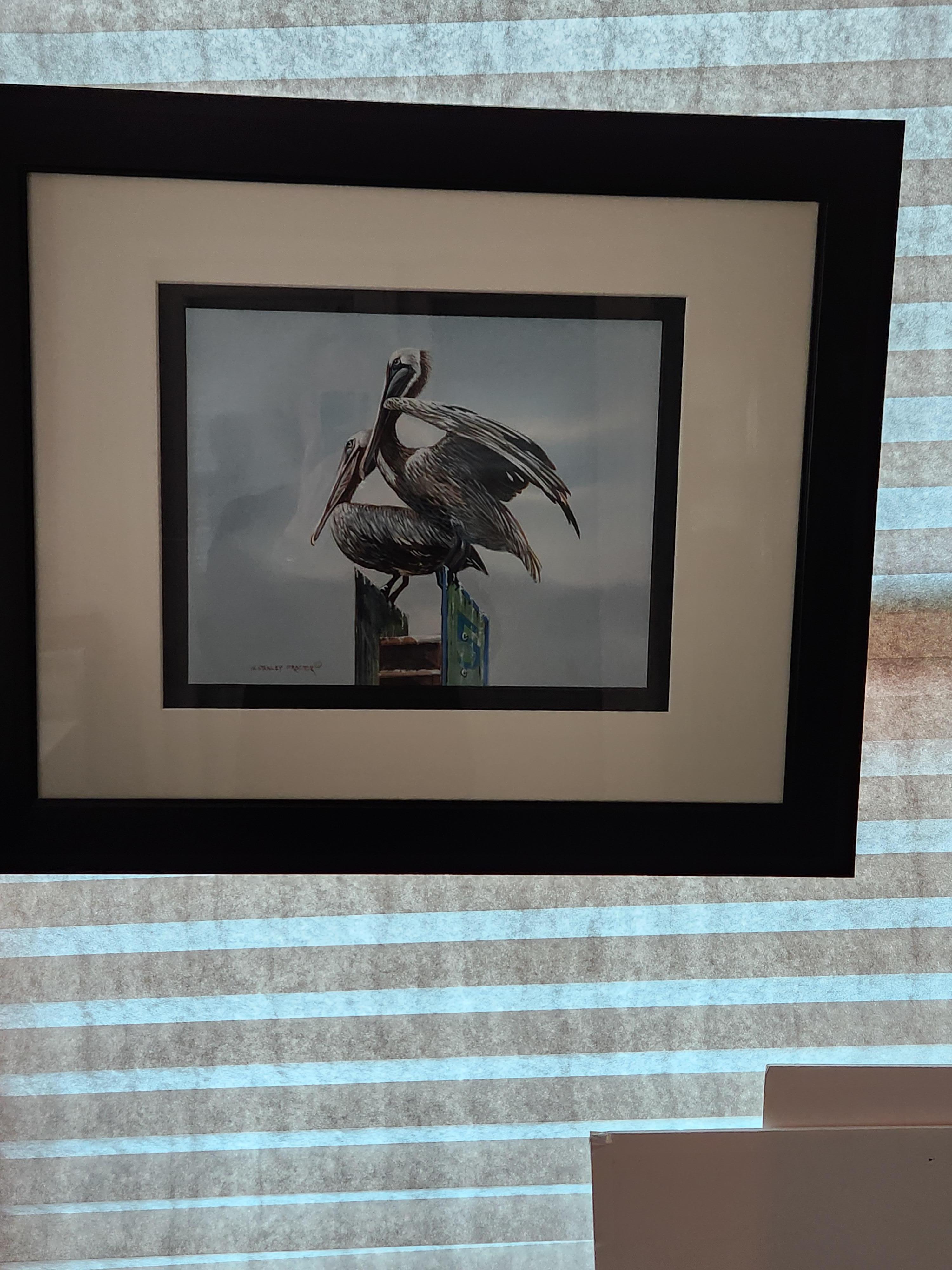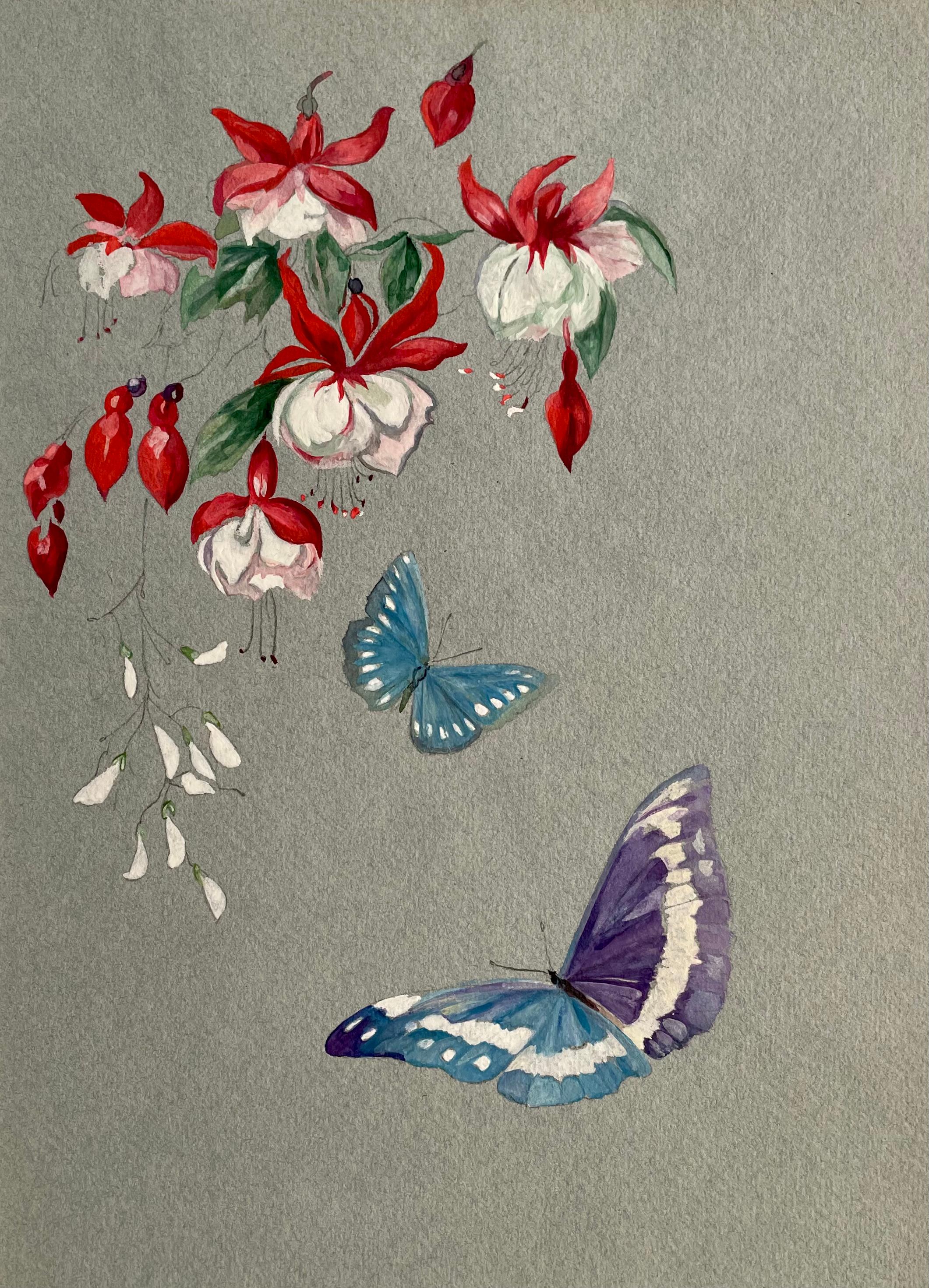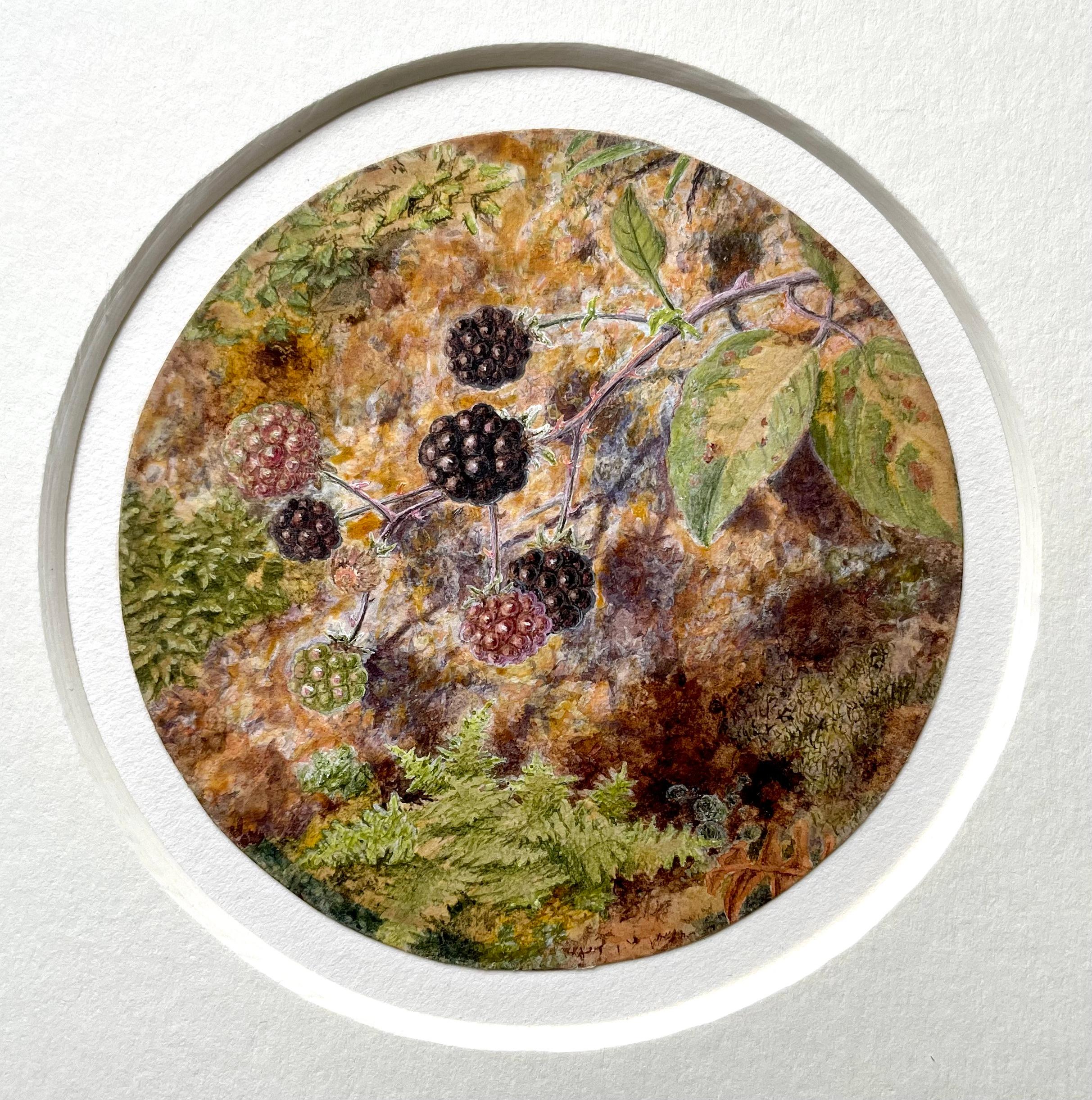Items Similar to Chrysanthemums and Tiger Lilies
Want more images or videos?
Request additional images or videos from the seller
1 of 10
Clarence Holbrook CarterChrysanthemums and Tiger Lilies1935
1935
About the Item
Chrysanthemums and Tiger Lilies
Signed and dated lower left (twice), see photo
Watercolor on paper, 1935
A symbol of the sun, the Japanese consider the orderly unfolding of the chrysanthemum's petals to represent perfection. Confucius once suggested they be used as an object of meditation. It's said that a single petal of this celebrated flower placed at the bottom of a wine glass will encourage a long and healthy life. Chrysanthemums are the flower for the month of November.
Provenance: Joseph M. Erdelac, Cleveland (noted collector and friend of Carter's)
This work was created during the 1930's when the artist was creating his best works. The 1930's work are the most highly sought after by collectors.
Regarding Carter:
A major watercolorist in the Cleveland, Ohio area in the early 20th century as well as teacher, Clarence Carter was born in Portsmouth, Ohio, and received recognition for his art talent beginning with his childhood.
From 1923 to 1927, he enrolled in the Cleveland School of Art and earned key patronage from William Milliken, Director of The Cleveland Museum of Art and local arts supporter who arranged for Carter to study in Italy with Hans Hofmann in 1927.
Through the next four decades, Carter's works were labeled Surrealism, Magic Realism, Geometric Abstraction, Pop and Op, but no category could capture his style completely.
From 1929 to 1937, Carter taught at the Cleveland Museum of Art, a job arranged by Milliken. From 1937 to 1938, he was Director of the Federal Art Project for Northeastern Ohio, and from 1938 to 1944, he taught at the Carnegie Institute. He also served as guest instructor at various institutions including the Minneapolis School of Art (1949), Lehigh University (1954), Ohio University (1955), Atlanta Art Institute (1957), Lafayette College (1961), and the University of Iowa (1970).
It was in the mid-1960's, in his series called "Mandalas," that his fascination with the egg-shaped ovoid began. Author James A. Michener has commented that the egg in Carter's works is ". . . a mysterious symbol evoking the past, the origins, the overtones of Christianity."
Carter was a member of the American Water Color Society and in 1962, served as Vice President. He used a watercolor technique that involved precise use of form, quick color washes and little retouching. From the beginning of his career, Carter painted in a modernist idiom characterized by a precise, realist line and strong psychological component. His work from the 1930s can be considered part of American Scene painting, and he was much concerned with the complex realities of American rural life.
There is a rich emotional quality to Carter’s work, and he once said “For me no great art has ever existed without some mystery and some awe. That is the vast intangible, which can never be defined but only felt in an elusive way that stirs the spirit.” (Frank Anderson Trapp, Clarence Holbrook Carter [New York: Rizzoli Books, 1989], p. 7)
Courtesy: AskArt
- Creator:Clarence Holbrook Carter (1904-2000, American)
- Creation Year:1935
- Dimensions:Height: 22 in (55.88 cm)Width: 14.75 in (37.47 cm)
- Medium:
- Movement & Style:
- Period:
- Condition:Original condition.
- Gallery Location:Fairlawn, OH
- Reference Number:
About the Seller
5.0
Recognized Seller
These prestigious sellers are industry leaders and represent the highest echelon for item quality and design.
Platinum Seller
These expertly vetted sellers are 1stDibs' most experienced sellers and are rated highest by our customers.
Established in 1978
1stDibs seller since 2013
711 sales on 1stDibs
Typical response time: 1 hour
Associations
International Fine Print Dealers Association
- ShippingRetrieving quote...Ships From: Fairlawn , OH
- Return PolicyA return for this item may be initiated within 10 days of delivery.
More From This SellerView All
- untitled (Reclining Female Nude)By Charles Harris ( Beni Kosh )Located in Fairlawn, OHAka Beni Kosh Still Life with Flowers Colored pencil on paper Unsigned Signed with the estate stamp on reverse (see photo) Estate No. 716 Condition: Soft fold through image, wri...Category
1960s Contemporary Still-life Drawings and Watercolors
MaterialsGouache
- untitled (Shell #773: Interior)Located in Fairlawn, OHUnknown Artist, Japanese, 20th century Unsigned Inscription in Japanese that repeats the EnglishCategory
20th Century Drawings and Watercolor Paintings
MaterialsWatercolor
- Baggage Claim, Bags #2By Darius StewardLocated in Fairlawn, OHSigned "Rhonda V" in memory of the artist's mother From the series: Baggage Claim, inspired by the death of the artist's mother. The reference to "Baggage" is symbolic to all the emotion and hurt one accumulates through life and how the accumulations weights down on the spirit. Watercolor on Yupo paper...Category
2010s Contemporary Still-life Drawings and Watercolors
MaterialsWatercolor
- Baggage Claim (Bags #1)By Darius StewardLocated in Fairlawn, OHCreated in 2017 this series, Baggage Claim, speaks to the symbolic emotional weight one accumulates through life and how the accumulations weigh down the spirit. The artist used handbags...Category
2010s Contemporary Still-life Drawings and Watercolors
MaterialsWatercolor
- Plum Branches and FlowersBy Joseph O'SickeyLocated in Fairlawn, OHPlum Branches and Flowers watercolor on wove paper, 1985 Signed and dated in pencil lower right corner From the artist's 1985 sketchbook Inspired by O'Sickey's love of Japanese and Chinese art and calligraphy. Provenance: Estate of the artist Condition: Excellent Image/Sheet size: 13 5/8 x 17 inches Joseph B. O’Sickey, Painter 1974 CLEVELAND ARTS PRIZE FOR VISUAL ARTS The title conferred on him by Plain Dealer art critic Steve Litt in a 1994 article, “the dean of painting in northeast Ohio,” must have pleased Joseph O'Sickey. It was more than 30 years since he had burst onto the local (and national) art scene. O’Sickey was already in his 40s in that spring of 1962 when he had his first one-man show at the Akron Art Museum and was signed by New York’s prestigious Seligmann Galleries, founded in 1888. In the decade and a half that followed, he would have seven one-man shows at Seligmann, which had showed the work of such trailblazing figures as Seurat, Vuilliard, Bonnard, Leger and Picasso, and appear in all of the group shows. O’Sickey took the Best Painting award in the 1962 May Show at the Cleveland Museum of Art (CMA). He and would capture the same honor in back-to-back May Shows in 1964 and ’65, and again in 1967. The remarkable thing, noted the Plain Dealer’s Helen Borsick, was that he accomplished this sweep in a variety of painterly styles, even using that most hackneyed of subjects, flowers. “The subject doesn’t matter,” he told her, “what the artist brings to it is the important thing.” O’Sickey’s garden and landscape paintings were big and bold, eschewing delicate detail in favor of vitality and impact. The great art collector and CMA benefactor Katherine C. White, standing before one of O’Sickey’s vivid garden paintings, compared the sensation to “being pelted with flowers.” Though he might represent an entire blossom with one or two smudged brush strokes or a stem with a simple sweep of green, O’Sickey rejected the moniker of Impressionist—or Pointillist or Abstract painter or Expressionist. “My work,” he said, “is a direct response to the subject. I believe in fervor and poetic metaphor. I try to make each color and shape visible and identifiable within the context of surrounding colors and shapes. A yellow must hold its unique quality from any another yellow or surrounding color, and yet read as a lemon or an object, by inference. It does not require shading or modeling—the poetic evocation is part of the whole.” “The subject,” O’Sickey used to tell his students at Kent State University, where he taught painting from 1964 to 1989, “has to be seen as a whole and the painting has to be structured to be seen as a whole.” He liked to think of it as “a process of controlled rapture.” When, in the 1960s, fond childhood memories drew him to the zoo, he found himself responding to the caged animals in their lonely dignity (or indignity) with sharp-edged, almost silhouette-like forms that evoked Matisse’s paintings and cut-paper assemblages. One observer was left with the impression that the artist had “looked at these animals, past daylight and into dusk when they lose their details in shadow and become pure shapes, with eyes that are seeing the viewer rather than the other way around. This is a world of shape and essence,” wrote Helen Borsick. “All is simplification.” O’Sickey attributed his ability to capture his subjects with just a few strokes—in an almost iconographic way—to a rigorous exercise he had imposed upon himself over a period of several months. Limiting his tools to a large No. 6 bristle brush and black ink, he set himself the task of drawing his pet parakeet and the other small objects in its cage (cuttlebone, feeding dish, tinkling bell) hundreds of times. The exercise gave him “invaluable insights into painting. . . . Because of the crudity of the medium, every part of these drawings had to be an invention and every mark had to have its room and clarity.” Then he began adding one color at a time—“still with the same brush and striving for the same clarity”—and headed off to the zoo where “the world opened up to me. I learned how little it took to express the subject.” Born in Detroit at the close of the First World War, O’Sickey grew up in St. Stanislaus parish near East 65th and Fleet on Cleveland’s southeast side. (The apostrophe was inserted into the family’s proud Polish name by a clerk at Ellis Island.) An early interest in drawing and painting may have been kindled by the presence on the walls of Charles Dickens Elementary School, one of only three grade schools in the district with a special focus on the arts, of masterful watercolors by such Cleveland masters as Paul Travis, Frank N. Wilcox and Bill Coombes. As a youngster O’Sickey took drawing classes at the Cleveland Museum of Art, and he and his brother spent hours copying famous paintings; while a student at East Tech High School in the mid-’30s, he attended free evening classes in life drawing with Travis and Ralph Stoll at the John Huntington Art and Polytechnic Institute, and Saturday classes at the Cleveland School (later the Cleveland Institute) of Art, where he earned his degree in 1940 under the tutelage of Travis, Stoll and such other legendary figures as Henry Keller, Carl Gaertner, William Eastman, Kenneth Bates...Category
1980s Contemporary Still-life Drawings and Watercolors
MaterialsWatercolor
- Still Life with Tromp L'OeilBy William SommerLocated in Fairlawn, OHGraphite and watercolor on a book page. Signed in ink by the artist lower right corner Provenance: Estate of the artist (Estate No. 00916 verso) Ray Sommer (the artist's son) Joseph M. Erdelac (No. 18 JME verso) Book page verso is an illustration of a Durer woodcut.Category
1920s Still-life Drawings and Watercolors
MaterialsWatercolor
You May Also Like
- PELICANSBy W Stanley ProctorLocated in Tallahassee, FLOriginal. Part of Artist's Personal Collection.Category
21st Century and Contemporary Realist Still-life Drawings and Watercolors
MaterialsWatercolor
- Early 20th Century British School watercolour of Butterflies and FuschiaLocated in London, GBBRITISH SCHOOL (Early 20th Century) Butterflies and Fuschia Watercolour and bodycolour over traces of pencil on blue paper Unframed, in mount only 33 by 24 cm., 13 by 9 ½ in. (mou...Category
Early 20th Century Realist Animal Drawings and Watercolors
MaterialsWatercolor
- William Shackleton - Camellia, pencil and watercolour by British SymbolistBy William ShackletonLocated in London, GBWILLIAM SHACKLETON, NEAC (1872-1933) Camellia, Kew Signed, extensively inscribed and dated ‘98 Pencil and watercolour Framed 33.5 by 27 cm., 13 ¾...Category
Late 19th Century Realist Still-life Drawings and Watercolors
MaterialsWatercolor, Pencil
- 1970s British watercolour of Rusting Cars by Ian HayLocated in London, GBIAN HAY (Born 1940) Cars Rusting Signed l.r.: Ian Hay; bears title and dated 1973 on exhibition label on the backboard Watercolour and gouache Framed 44 by 88 cm., 17 ¼ by 34 ¾ in...Category
1970s Realist Landscape Drawings and Watercolors
MaterialsWatercolor, Gouache
- John Ward, RA - 20th Century British Still Life Watercolour DrawingLocated in London, GBJOHN STANTON WARD, RA, RWS (1917-2007) Glasses, Branches and Paper Signed and dated 1960 Pen and ink, pencil and watercolour 47 by 63 cm., 18 ½ by 24 ¾ in. (frame size 64.5 by 80.5 cm., 25 ¼ by 31 ¾ in.) Provenance: Private collection since 1961. Ward was born in Hereford, where his father, Russell Stanton Ward, ran an antiques shop and restored paintings. He studied at the Hereford School of Arts and Crafts before winning a place to the Royal College of Art in 1936, where he studied under Gilbert Spencer, Charles Mahoney and Alan Sorrell and won the prize for drawing. During World War II he served in the Royal Engineers, using his drawing skills to design pillboxes, and later taking part in the D-Day landings. He was posted to Belgium after the war before returning to the Royal College to graduate in 1946. Ward worked as a painter, illustrator and teacher, happy to work in oils, watercolour, pastel and pen and ink. He painted portraits, landscapes, interiors and architectural subjects, undertaking portraits of members of the royal family, businessmen and celebrities including the Princess of Wales, the Princess Royal and the christenings of Prince William and Prince Harry. Fifteen of his portraits are in the collection of the National Portrait Gallery and he held one man shows at Agnew’s and the Maas Gallery. As a prolific illustrator he worked on guides to Herefordshire and North Yorkshire and produced illustrations for Vogue magazine from 1948 to 1952 and illustrated many books including Laurie Lee’s Cider with Rosie (1959) and H E Bates...Category
Mid-20th Century Realist Still-life Drawings and Watercolors
MaterialsInk, Watercolor
- 19th Century British School watercolour still life of BlackberriesLocated in London, GBBRITISH SCHOOL (19th Century) Blackberries Watercolour and bodycolour, circular Unframed, in mount only Diameter 8 cm., 3 ¼ in. (mount size 21.5 by 21 cm., 8 ½ by 8 ¼ in.)Category
Mid-19th Century Realist Still-life Drawings and Watercolors
MaterialsWatercolor
Recently Viewed
View AllMore Ways To Browse
Atlanta Art
Art And Surrealism And Painting
Line And Wash
Vintage Lilies
Art With Tigers
Tiger Art and Photography
Painting And Water Glass
Tiger Painted
Tiger Paint
Tiger Italy
Paintings Of Tigers
Chrysanthemums In Art
Paintings With Tiger
Chrysanthemum Japanese
Chrysanthemum Japan
Vintage Sun Drawing
Drawings Of Rural Life
Water Lily Art




